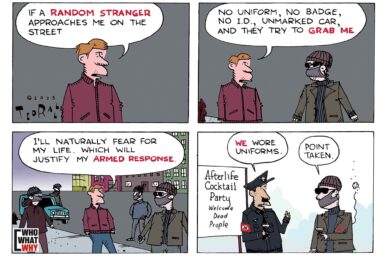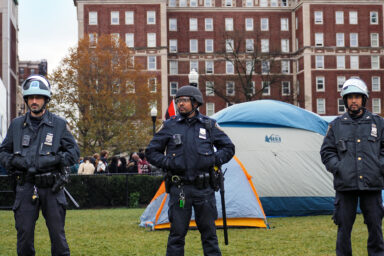A nonprofit teaches observers how to intervene when they witness harassment.
In a busy shopping area in New York City, a tour guide had to make a split-second decision. A stranger had overheard two Asian men mentioning their nationalities to the guide, and he suddenly attacked them. The attacker punched and pummeled the pair until the tour guide intervened and scared him away. Three days later in San Francisco, a security guard and a construction worker stepped in when an elderly Asian woman was being robbed. They chased the mugger and cornered him until police arrived.
While most witnesses to such events are not in a position to intervene in this way, which could put themselves at risk, activists say it’s vital to show people how not to be passive bystanders as attacks on Asians multiply around the US.
President Joe Biden recently signed the COVID-19 Hate Crimes Act into law, but it focuses on making it easier for non-English speakers to report hate crimes online and provides funding for state-run hate-crimes hotlines. Far away from the Oval Office, groups like New York City-based nonprofit Hollaback! say there also needs to be a more citizen-focused approach, given that many bystanders turn a blind eye to the violence in front of them.
Hollaback! conducts free bystander intervention training that has drawn tens of thousands of participants from around the world, many of them women. In April, women made up 89 percent of participants at an anti-Asian harassment training attended by 600 people, including this reporter. The weekly virtual workshops on bystander intervention and conflict de-escalation as it relates to violence against Asians are conducted in partnership with Asian Americans Advancing Justice, a nonprofit based in Washington, DC.
“The 5 D’s”
Hollaback! focuses on what it calls the 5 D’s: distract, delegate, document, delay, and direct.
1) Distract is what they describe as creating a distraction that could bring an end to the harassment without addressing it directly. Hollaback! suggests starting a conversation with the victim or finding another way to draw attention away from them, like asking for directions or the time, or conspicuously “dropping” something at the scene.
2) Delegate is asking for help from others nearby, particularly someone in a position of authority — such as a bus driver if you’re on a bus, the managers or security guards if you’re in a store, a teacher if you’re in a school, a flight attendant if you’re on an airplane. At this point, audience members often ask the hot-button question: What about calling the police? Hollaback! hasn’t shied away from responding.
“In the trainings, what we tell people is that as a general rule in nonviolent situations, we would encourage people, not for their automatic first step to be, to call the police,” said training facilitator Marita Etcubañez, senior director of strategic initiatives of Asian Americans Advancing Justice. “In nonviolent situations, we recommend that people check in with the person that’s facing the harassment or conflict and ask what they want to do. We also say that if there is a serious threat to safety [or] if there is violence happening, if someone needs immediate medical attention, then by all means, call the appropriate authorities.”
Gabriela Mejia, a Hollaback! trainer who has doubled as a spokesperson for two years, suggests being explicit in emergency calls about requesting people trained for mental health crises. She notes the potential harm in calling police on vulnerable groups of people.
“At a glance you don’t know a lot about a person,” said Mejia. “You don’t know their immigration status. You don’t know any past experiences they or a loved one in their community has had with the police.”
But she also opened up about the challenges of navigating through a national reckoning with police violence and accountability as a bystander intervention trainer. “The reality is that I need to give someone tools that are going to be useful for them in real-life moments, and not to just agree with my own politics or with their politics,” said Mejia. “Our responses always have to be more nuanced to really solve these complicated situations.”
3) Document is capturing visual evidence of the harassment taking place. Mejia said it “can be a little bit instinctual to us” to take out a phone and take a picture or a video that will be helpful to the victim. Other tips from Hollaback! include filming street signs or other landmarks and verbally stating the date and time. They stress that bystanders should not post the footage online without trying to get the permission of the person who was harassed.
4) Delay is showing support for the person who was harassed, after the harassment has ended. Hollaback! suggests asking these three check-in questions: “Can I sit with you? Can I accompany you somewhere? What do you need?”
Dax Valdes, a senior trainer who joined Hollaback! last June, said becoming a trainer has changed his attitude about intervening. “When I would see an altercation, if I didn’t know the people and neighborhood, I would just keep my head down,” said Valdes. “But after I worked with Hollaback! and knowing what I know, it’s too hard to ignore things now.”
Valdes said that he became more “hyperaware” last summer when he participated in Black Lives Matter protests. “When I see cops talking to Black people on the street, I find myself slowing down to examine,” said Valdes. (Hollaback! started offering a “Bystander Intervention to Stop Police Sponsored Violence and Anti-Black Racist Harassment” training in June 2020 following the police killings of George Floyd and Breonna Taylor.)
Valdes said he hasn’t used his bystander intervention skills for anything serious yet. But he recalled a recent altercation where he used “delay” at a Costco in New York City. “It was a fight about not wearing a mask,” recalled Valdes. “One of the customers spat on a guy. It missed him, but it hit a [Costco] employee. On the way out, I saw that employee again, and said, ‘Are you okay? I saw what happened earlier.’ She looked surprised for a minute and she went, ‘Yes I’m okay. Thank you for asking.’ That small action of checking in on her — I hope it goes a long way.”
5) Direct is directly speaking to the harasser in a way that could de-escalate the situation. This approach isn’t about having a screaming match and exchanging heated expletives with a stranger. “I know people very close to me who can’t use ‘direct’ to de-escalate a situation because they will escalate a situation by their tone, in how they carry themselves, and how other people perceive them,” Mejia said in a training. Essentially, Mejia advises people with short tempers to instead try the four other approaches.
Most Hollaback! trainers said they naturally use the “direct” approach. “I’m a lawyer by training,” said Etcubañez. “I feel like that’s my go-to; just to take it on and talk about it. But I think after going through these trainings and teaching these tactics all the time, I feel ‘delay’ is the most important — checking in on the person afterwards and offering assistance.”

In one situation in her New York City neighborhood, Mejia used both the “direct” and “delegate” approaches to intervene in a street harassment situation. She said she made sure that the person doing the harassment knew it wasn’t acceptable. “It’s a difficult relationship that I have with harassment in my neighborhood,” said Mejia of some situations. “I would never call the cops because they’re old Latino men and I’m a Latina woman. But I found that bystander intervention really empowered me to start putting an end to their behaviors.”
The only form of anti-Asian harassment Mejia has witnessed so far was on social media, and it was near the start of the pandemic. “It was harassment in the form of memes or jokes,” said Mejia, who commented on one such racist post and initiated conversation.
Many victims have not been fortunate to have a bystander intervene. In a high-profile incident, 65-year-old Vilma Kari, a Filipino American, was viciously assaulted, and severely injured, on March 29 outside a residential building in Manhattan. The surveillance footage of the incident showed several building workers inside who were slow to react, with one even closing a door before the footage ended. The lack of visible help and support Kari received infuriated many in and beyond the Asian, Asian American, and Pacific Islander community.
“It’s the one that definitely stuck with me,” Mejia said about that attack. “The more people can understand how to de-escalate a situation, the easier it’s going to be for us to intervene on behalf of each other and protect each other.”
Mejia believes that just one bystander intervention training can change your perspective enough to make sure that you are helpful the next time you see harassment. “We really want to have people just commit one hour of their time,” said Mejia. “From my own journey as someone trying to make some change, it really sunk into my consciousness after I took three [trainings].”

What Is Hollaback!? How Has the Training Been Received?
Since 2005, Hollaback!’s team has been gathering stories about harassment through a self-reporting form on its website — starting first with street harassment experienced by women and LGBTQ+ individuals. Over the last 15 years, Hollaback! has received more than 16,000 accounts of harassment from around the world. In 2013, the nonprofit decided to create a methodology to disrupt harassment in the workplace. This included creating an online platform to report harassment and providing training in bystander intervention.
Hollaback!’s history began with a group of friends living in New York City. “They were talking about what it was like living in New York City,” said Mejia. “They realized that some people in the group were being harassed a lot more often on the street. They decided to create a platform where people could share their stories.” By “some” in the group, Mejia means the women. The group, including Hollaback! co-founder Emily May — who has written about sexism and sexual violence in pieces like “Your Catcalls Have No Place Here” and “Replacing Sexism with Racism Is Not a Proper Hollaback” — was mostly inspired by news about a New York woman named Thao Nguyen documenting her harasser in the subway.
“What began as a simple idea, a blog to collect women’s and LGBTQ+ individuals’ stories of street harassment, became part of an international movement,” May told WhoWhatWhy. “I think this moment will shine a light on racism in the AAPI community and be a catalyst for broader efforts to address the long-standing racism.”
With some help from New York City councilmembers, cosmetics company L’Oreal Paris, the New York City Commission on Gender Equity, and the New York City Mayor’s Office, Hollaback! pledged to help end domestic and gender-based violence and train people in harassment intervention. May’s LinkedIn page states that Hollaback! pushed for an anti-harassment campaign in the city’s mass transit system and, in 2012, connected the Hollaback! mobile app with New York’s City Council, “making it the first city in the world to track street harassment.”

Its training evolved in April 2020 in response to growing anti-Asian violence. Participants can expect targeted questions and topics tying back to Asian identities. “What percentage of Asian Americans have witnessed someone blaming Asian people for COVID-19?” is one such question in the training. Now, Hollaback! claims it’s trained over 65,000 people in bystander intervention in more than 40 states. In May alone, the nonprofit presented over 50 seminars for companies across the US.
Two attendees, who have both suffered harassment, said the anti-Asian street harassment workshops were comprehensive in introducing bystander intervention, but were not nuanced enough.
Chanda Briggs, a biracial Black woman, said she did find some of it useful. “I think it appeals really well to people who maybe don’t have an awareness of these issues and just don’t know where to begin,” said Briggs. She said she was disappointed when, as a response to the question of why they don’t intervene in situations, Briggs saw how many people said they didn’t want to look like white saviors. She said this response was indicative of the larger issues at hand. She added: “What else can we do? How can we change things on a more ideological or conversational level every day so we can avoid these things from happening in the first place?”
Sydney Ji, who identifies as Chinese, has been to a few training sessions. “While I appreciated the scenarios they had us go through and the introduction of various techniques people can use, I felt that more political education on the historical context and systemic issues that impact so-called hate crime incidents was needed and was disappointed that this was not more heavily integrated into the trainings,” said Ji.
And so the training will go on, but a post-pandemic world triggers concerns about escalated aggression.
“We are worried about what’s going to happen as the restrictions lift,” said facilitator Etcubañez. “Does this mean there will be even more opportunities for conflict? We often cite the increased harassment and violence that the MASA [Muslims, Arabs, and South Asian] community faced after 9/11. That was more than 20 years ago and it’s not going away. Unfortunately I don’t think this is going to dissipate as we come out of the pandemic.”
Related front page panorama photo credit: Adapted by WhoWhatWhy from Scottish Government / Flickr (CC BY 2.0).



